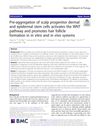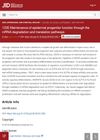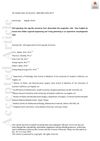Search
forLearn
4 / 4 resultslearn Epidermal Growth Factor
learn Low Level Laser Therapy
laser therapy for anti-inflammatory and likely insignificant hair regrowth effects
learn Osteopontin
signaling protein that, when suppressed, may grow hair by reducing inflammation and stem cell loss
Research
5 / 1000+ results
research Pre-Aggregation of Scalp Progenitor Dermal and Epidermal Stem Cells Activates the WNT Pathway and Promotes Hair Follicle Formation In Vitro and In Vivo Systems
Grouping certain skin cells together activates a growth pathway that helps create new hair follicles.

research Maintenance of Epidermal Progenitor Function Through the mRNA Degradation and Translation Pathways
The protein DDX6 helps keep skin cells renewing properly by controlling the production of certain other proteins and breaking down those that cause cells to mature too quickly.

research Self-Organizing Hair Peg-Like Structures From Dissociated Skin Progenitor Cells: New Insights for Human Hair Follicle Organoid Engineering and Turing Patterning in an Asymmetric Morphogenetic Field
Researchers created early-stage hair-like structures from skin cells, showing how these cells can self-organize, but more is needed for complete hair growth.
research P63 Expression Pattern During Rat Epidermis Morphogenesis and the Role of P63 as a Marker for Epidermal Stem Cells
P63 is a marker for epidermal stem cells in rats.

research Lineage Analysis of Epidermal Stem Cells
Skin stem cells maintain and repair the outer layer of skin, with some types being essential for healing wounds.
Community Join
5 / 81 resultscommunity New and Interesting HairLoss Studies/Papers/Reviews
Hair loss treatments discussed include Dutasteride with Ketoconazole, tissue engineering strategies, and androgenetic alopecia therapies. Massage doubles follicular retention, improving treatment effectiveness.
community The Real Cause Of Androgenetic Alopecia
Androgenetic alopecia is caused by DHT affecting hair growth. Finasteride and minoxidil are used to manage hair loss by blocking DHT and promoting hair growth.
community Confused why people are calling PP405 a cure...it never claimed to be able to undo miniaturization or revert vellus back to terminal hairs. It seems to be more of a growth stimulant like minoxidil.
PP405 is not a cure for hair loss but may reactivate dormant hair follicles, similar to minoxidil. It is unlikely to help with miniaturized or vellus hairs and is still in trial phases, with availability expected around 2030.

community Compressed part of research of theory of androgenic/anabolitic balance. AGA h-responders analytic. Theory of physio-metabolitic method of anti AGA treatment
The treatment for androgenetic alopecia involves using finasteride and minoxidil with intense exercise and cold exposure to boost metabolism and reduce androgenic effects, potentially leading to hair regrowth. This approach may activate biological pathways for improved hair and overall health.
community Clearing the air on how non-surgical treatments really work
Treatments for hair loss, including finasteride, dutasteride, minoxidil, ketoconazole, microneedling, and low level laser light therapy, which aim to reduce DHT production, increase cell absorption and blood flow, and stimulate epidermal stem cells. It also stresses the importance of patience when using these treatments.